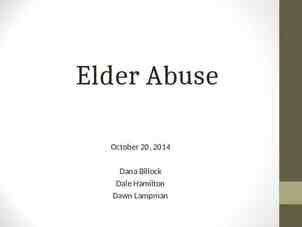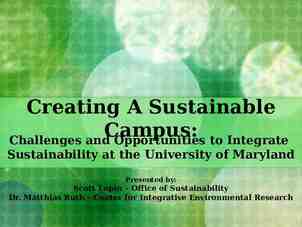Eye Witness to Peace 191820: Primary Sources from LSE Archives The
27 Slides3.64 MB

Eye Witness to Peace 191820: Primary Sources from LSE Archives The resource is linked to sections on the League of Nations in the Giving Peace a Chance: From the League of Nations to Greenham Common exhibition at LSE Library 4 January – 17 April 2019, curated by Professor David Stevenson, LSE International History.

Armistice Armistice means a break in armed conflict while both sides negotiate peace. The armistice at the end of World War One on 11 November 1918 was officially a cessation of fighting but became the end of most armed conflict.

The Main Events to Armistice By 3 November 1918 the German allies of Bulgaria, the Ottoman Empire, the Astro-Hungarian Empire had all agreed to an armistice. 4 October: Germany in negotiations with America and then the British and French about an armistice 3 November German sailors mutinied. A maritime blockade had contributed to hunger leading to strikes and riots The influenza epidemic killed 100,000s of people. A German delegation arrived at the mobile HQ of Marshall Fochs in a forest near the Western Front on 8 November. 9 November Kaiser Wilhelm II abdicated. The German military advised the new government to sign the armistice. By early morning 11 November 1918, the armistice was signed and came into effect at 11am the same day.

Peace in Europe? At 11am on 11 November 1918, war finally ended on the Western Front. War had officially ended on many of the other fronts but in some areas, cessation of the main war had meant a descent into smaller nationalist or civil wars. Robert Gerwarth writes that: “As civil wars overlapped with revolutions, counter revolutions and border conflicts between emerging states without clearly defined frontiers or internationally recognised governments, ‘post-war’ Europe between the official ending of the Great War in 1918 and the Treaty of Lausanne in July 1923 was the most violent place on the planet.”

Beatrice Webb (1858 – 1943): Eye Witness Beatrice Webb was a sociologist, social reformer and a founder of the London School of Economics (LSE). Like many of the social scientists and economists based at LSE, Webb was invited to assist the government with war and post war social planning. Beatrice kept a lengthy diary that, due to her good social and political connections and work with government, is a rich source of evidence to historians. http:// www.lse.ac.uk/about-lse/lse-leading-women/biographie s/beatrice-webb Beatrice Webb with her nephew, 1900. LSE Imagelibrary/1359.

Beatrice Webb, Diary on 11 November 1918 https://digital.library.lse.ac.uk/objects/lse:buh232top:

Source Exercise Who is Beatrice Webb referring to as Berlin’s / the German peoples’ ‘oppressors’? What does she mean by ‘property’? Why are there concerns about ‘revolution’ and why are ‘men of property trembling’? From reading this account, what challenges do you think there are in victory? What ‘side’ do you think Beatrice Webb is on – the ‘men of property’ or revolution?

Centenary of Armistice In 2018, on the centenary of the armistice, this extract from Beatrice Webb’s diary was read in Westminster Abbey in front of Queen Elizabeth II and His Excellency Frank-Walter Steinmeier, President of the Federal Republic of Germany. Why do you think this was? How important was it that the Heads of Britain and Germany attended the same commemoration? Why do we remember those who died in war on 11 November? Peace! London to-day is a pandemonium of noise and revelry, soldiers, and flappers being most in evidence. Multitudes are making all the row they can, and in spite of depressing fog and steady rain, discords of sound and struggling, rushing beings and vehicles fill the streets. Paris, I imagine, will be more spontaneous and magnificent in its rejoicing. Berlin, also, is reported to be elated, having got rid not only of the war, but also of its oppressors. The peoples are everywhere rejoicing. Thrones are everywhere crashing and the men of property are everywhere secretly trembling. ‘A biting wind is blowing for the cause of property’, writes an Austrian journalist. How soon will the tide of revolution catch up with the tide of victory? That is a question which is exercising Whitehall and Buckingham Palace and which is causing anxiety even among the more thoughtful democrats. Will it be six months or a year? Beatrice Webb, Diary Entry for 11 November 1918

The Blockade on Central Europe Aftermath in Central Europe: the German delegation at the negotiations for the armistice desperately tried to call off the Allied maritime blockade as part of armistice. The Allies refused until a peace treaty had been signed. The blockade, territory confusion and war as well as the influenza epidemic meant that there were starving populations in Germany, Austria, Poland and Russia. In 1919 the Fight the Famine Council (FFC) was founded. It was an apolitical humanitarian attempt to save lives. An example of internationalism, it operated across borders and appealed beyond nationalist sentiment. Image: The Policy and Work of the Fight the Famine Council (LSE Archives: 7EJB/C/09)

Eglantyne Jebb (1876-1926): Eye Witness Eglantyne studied economics and wrote on social reform, mainly on agriculture and bridging social class divisions, in the 1900s. During the First World War she supported her sister Dorothy Buxton in printing news of what was going in Germany and Austria, highlighting the starvation the blockade was causing at the end of the war. They founded the Fight the Famine Committee in 1919 with Lord Parmour, Kate Courtney and Marian Ellis. Jebb later researched and published The Children’s Charter in 1923 for protecting the welfare of children across nations, which was adopted by the League of Nations the following year.

Starving Children The FFC distributed food and milk based on new nutritional understanding in food health and medicine, pioneered by scientists such as Harriette Chick. It was not just that there were shortages of food, but that there was shortages of protein and milk, which particularly affected children. The FFC operated an emotive campaign using photographs of emaciated infants to raise sympathy and money. The charity Save the Children Fund was formed from the FFC due to the amount of starving babies and children, who be seen as ‘innocent’ of the war and so were easier to campaign for. The below report illustrates the issues created by the lack of milk cows in Germany: doubled infant mortality, doubled fatal tuberculosis, a lack of medicine and ‘nourishing foods’ and mothers unable to breast feed. 1919 Report Milk Shortage and Child Mortality in Germany, Fight the Famine Committee, Archives of Eglantyne Jebb, The Women’s Library Collection LSE.

Paris Peace Conference January 1919 delegates from 32 countries met in Paris to agree the terms of the end of the First World War. The conference was dominated by David Lloyd George (Britain), Georges Clemenceau (France) and Woodrow Wilson (USA); they were known as the ‘Big Three’. These three leaders representing their countries wanted very different outcomes from the peace negotiations: Lloyd George wanted to keep the British Empire intact with British domination of the sea. Clemenceau wanted reparations from and revenge on Germany. Wilson had published 14 points for a lasting peace that promised to rebuild Europe, independence for colonised peoples and new forms of international cooperation. Wilson, however, did not have political control of the legislative bodies of the USA. There were enormous amounts of officials and documents involved in this process.

Woodrow Wilson’s 14 points These included: Setting up a League of Nations Disarmament Self-determination for the people of Europe – the right to rule themselves Freedom for colonised peoples Freedom of the seas Free trade Wilson conceded most of the points to keep the League of Nations, even the War Guilt Clause, which he hated as it explicitly blamed Germany for the war.

Charles Kingsley Webster (1886-1961): Eye Witness. In 1919 Charles Webster was an assistant in the Military Section of the British delegation at the Paris Peace Conference. Having served in intelligence during the war, Webster was a historian. Webster’s papers give an insight into the fraught negotiations going on in 1919. He later became a professor in international history at LSE and was integral to the British government’s preparations for the United Nations during the Second World War. This photograph shows Webster (third from the left) at the signing of the United Nations Charter in San Francisco on 26 June 1945 .

The Key Terms of the Treaty of Versailles There were 440 terms in the treaty with Germany. The main ones were: Territorial Lands in eastern Germany were given to Poland The Alsace-Lorraine region returned to France Military Germany was not allowed an air force, the navy was restricted to six battleships and no submarines, and only 100,00 men in its army. Financial Pay 132 billion marks in reparations to the Allies and countries it had occupied. Punishment Germany was forbidden to unite with Austria Accept all responsibility for loss and damage caused by the war The coal mining area of the Saar was given to France for 15 years. Not allowed to join the League of Nations

The Response of the German Delegation Germany thought that the terms of the peace treaty would be based on Wilson’s ‘fourteen points’ not the harsh terms of the armistice. The victorious allies based the negotiations on the terms of the armistice. The Germans were humiliated, in the midst of political upheaval and economic turmoil, with their people starving. This was the response of the German delegation to the Treaty in May 1919, but they were given no option for negotiation. On 28 June 1919, the delegates met at the Palace of Versailles near Paris. The treaty was signed in the Hall of Mirrors by the leaders of the allies and two of the German delegates. Translation of the German response to the draft Treaty of Peace (LSE Archives Webster/ 3 / 10).

German Delegation Response: Exercise What do you think the Germans are referring to by ‘the peace of justice’? Why would the Germans describe the Treaty as ‘victorious violence’? Given the treaty was more than ‘the German people can bear’, why do you think the delegates signed it?

Treaties with German Allies Four other treaties were made with the countries that had been allied with Germany during the war. These were Turkey, Hungary, Austria and Bulgaria. All the terms were based on those in the Treat of Versailles: disarmament, a set amount of reparations, lost land and new countries formed out of land they conceded. This is the end of a letter from Lieutenant Colonel W. L. G. Twiss, to Charles Webster after he had was working at the University of Liverpool. Twiss was negotiating with Austrians in Paris in what would become known as the Treaty of Saint Germaine (10 September 1919). Letter from Twiss to Webster, 28 August 1919, Paris. LSE Archives Webster/1/3 . Well I must to bed. How is the history progressing? Don’t forget to bring out our success in getting the Huns fed, and having a few reasonable modifications made to the peace treaty. (Transcript of above)

Opinions about the Treaty: Exercise It is well known that Germans hated the Peace Treaty. Opinion about it was even divided in Britain. Even Lloyd George thought it was too harsh and predicted another war. Historian David Reynolds has argued that ‘It was a messy compromise between the Big Three.’ In 1919, our eye witness, Charles Webster was writing an essay for A History of the Peace Conference of Paris (published 1920-1924), which was edited by the diplomatic historian Harold W. V. Temperley. This is a section from Temperley’s ‘Instruction to authors’; he singles out the treaty as establishing law and internationalism. Does Temperley have a point about the positive effects of the treaty? Can you see any issues with writing a historical account of the Treaty so close to 1919? As a historian looking at the Treaty today, what would those issues be?

The League of Nations The League of Nations was one of US President’s Woodrow Wilson’s fourteen points to create a ‘world safe for democracy’. Wilson conceded almost every point to get the established. However, the American Senate never ratified the covenant for the USA joining the League of Nations. The League was set up for nations to solve their differences through discussion rather than armed conflict. Its aims were: to stop war, encourage disarmament and improve living conditions for people globally, through tackling disease and poverty. The first meeting of the League in January 1920.

Catherine Marshall (1880-1961): Eye Witness Marshall had been a suffragist, working for the National Union of Women’s Suffrage Societies (NUWSS), based in Keswick in the 1900s. She was a pacifist and left the NUWSS over their support for the war in 1914. Marshall helped to plan the Women’s International Congress – a peace conference – in Holland in 1915 but was not allowed to attend. She helped to found what became the Women’s International League for Peace and Freedom (WILPF), a pressure group for peace, disarmament and recognising women’s rights. A New Peace, Report of the International Conference of Women at The Hague, 1922, Catherine Marshall is on the left. LSE Archives: WILPF/5/8

Support for League of Nations Women’s International League for Peace and Freedom (WILPF) met in Zurich May 1919. At this meeting WILPF formally ‘regretted’ the terms of the Treaty of Versailles and condemned the continued blockade of Germany and Austria, as this report shows. WILPF welcomed the establishment of the League of Nations. The Group set up an office in Geneva, where the League was based, to lobby and support it.

The Structure of the League of Nations Assembly: all member states could send three delegates, one vote per state met once a year in Geneva. emergency meetings could be called decisions needed to be unanimous. in 1920 there were 42 members Council: smaller decision-making body made up of Britain, France, Italy and Japan with 4 non-permanent members that rotated every 3 years, later 6 in 1922, then 9 in 1926 and 11 in 1939. Met 4 times a year. Eyewitness Catherine Marshall asked for the rules of procedure for the first League meeting in 1920. WILPF. She discovered that many of the meetings were ‘closed’ and so WILPF lobbied for greater transparency in the League with some success.

The Wider role of the League of Nations The League’s main role was to prevent armed conflict between countries and settle disputes through negotiation. However, it had a wider remit to promote disarmament, the raising of living standards and to protect human rights for men, women and children. The Court of International Justice sat in The Hague with 15 judges from 15 different countries. International Labour Organisation met once a year with a mandate to improve living and working conditions. It monitored the administration of ‘mandate’ territories, former territories that had been part of the German or Ottoman Empire. There were also a number of different League Bureaus to supervise the protection of refugees and other issues.

Rachel Crowdy (1884-1964): Eye Witness Crowdy had trained as a nurse in the 1900s and joined the Voluntary Aid Detachments in 1911 and was in charge of the VADs in France of Belgium, an enormous administrative undertaking. In 1919 she was appointed to head the section on social issues at the League, which she did until 1931. Crowdy was the only woman to do head up a League bureau. She led respected international inquiries and set out measures to stop opium and women and children trafficking (slavery). Dame Rachel Eleanor Crowdy, by Bassano, October 1930, NPG x68898 National Portrait Gallery, London

Trafficking of women and children Alison Neilans was the secretary of the Association for Moral and Social Hygiene (AMSH), a pressure group formed to protect women and children from rape, coercion, prostitution and sexual abuse. Rachel Crowdy is responding to Neilans’ concerns that the international legal agreements to stop and monitor examples of trafficking of women and children were not being applied by Britain and France in Mandate territories in the Middle East. Letter from Rachel Crowdy in response to Alison Neilans, LSE Women’s Library Archives: 3AMS/B/11/.

League of Nations Union In 1918 two internationalist societies formed to create the League of Nations Union and became a leading pressure group. The League and the Union was very popular in Britain and had over 400,000 members at its peak. The League represented a utopian ideal for how to avoid war and encouraged disarmament. From a contemporary perspective, it is difficult to get a sense of how new this internationalist method of doing things was. The League and the Union directly influenced the formation of the United Nations in the closing stages of World War Two.






